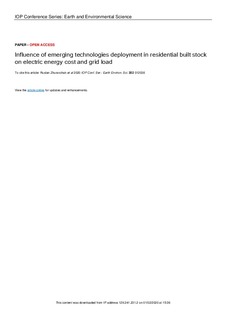| dc.contributor.author | Zhuravchak, Ruslan | |
| dc.contributor.author | Nord, Natasa | |
| dc.contributor.author | Brattebø, Helge | |
| dc.date.accessioned | 2020-02-03T07:20:23Z | |
| dc.date.available | 2020-02-03T07:20:23Z | |
| dc.date.created | 2020-01-29T20:59:40Z | |
| dc.date.issued | 2019 | |
| dc.identifier.citation | IOP Conference Series: Earth and Environmental Science (EES). 2019, 352 | nb_NO |
| dc.identifier.issn | 1755-1307 | |
| dc.identifier.uri | http://hdl.handle.net/11250/2639141 | |
| dc.description.abstract | High penetration rates of novel building energy technologies has prompted a growing concern about their microeconomic effect and grid influence. Deployment of photovoltaic (PV), solar water heating (SWH) systems and energy storage solutions, in addition to the growth of electric vehicles (EV) fleet, are reshaping the structure of built stock and lead to the changes in its electric energy demand profile. Long-term forecasting of such structural changes is necessary to guide the decision-making process that would satisfy the needs of both, energy consumers and the suppliers. Whereas electric energy price model is one of the key influencing factors of technologies acceptance for households, peak loads and grid feed-in determine the needed capacity of power grids. The objective of this study was to assess both, the aggregated cost of energy and the changes in cumulative load profiles that are excepted by 2050 for one of residential building typologies in Norway. Methodologically, it was achieved with descriptive statistics, stochastic forecasting and detailed energy performance simulation. Annual electric energy cost for consumers were evaluated under six pricing models. The results suggested that time-of-use and variable maximum power extraction models represent the lowest and the highest extremes in energy cost. At the aggregated level, peak load will decrease in range 1% to 13% compared to current level. Peak PV feed-in will reach up to 40% of peak load by 2050. | nb_NO |
| dc.language.iso | eng | nb_NO |
| dc.publisher | Institute of Physics, IOP Science | nb_NO |
| dc.rights | Navngivelse 4.0 Internasjonal | * |
| dc.rights.uri | http://creativecommons.org/licenses/by/4.0/deed.no | * |
| dc.title | Influence of emerging technologies deployment in residential built stock on electric energy cost and grid load | nb_NO |
| dc.type | Journal article | nb_NO |
| dc.type | Peer reviewed | nb_NO |
| dc.description.version | publishedVersion | nb_NO |
| dc.source.volume | 352 | nb_NO |
| dc.source.journal | IOP Conference Series: Earth and Environmental Science (EES) | nb_NO |
| dc.identifier.doi | 10.1088/1755-1315/352/1/012038 | |
| dc.identifier.cristin | 1785682 | |
| dc.relation.project | Norges forskningsråd: 268248 | nb_NO |
| dc.description.localcode | Content from this work may be used under the terms of the Creative Commons Attribution 3.0 licence. Any further distribution of this work must maintain attribution to the author(s) and the title of the work, journal citation and DOI. | nb_NO |
| cristin.unitcode | 194,64,25,0 | |
| cristin.unitname | Institutt for energi- og prosessteknikk | |
| cristin.ispublished | true | |
| cristin.fulltext | original | |
| cristin.qualitycode | 1 | |

